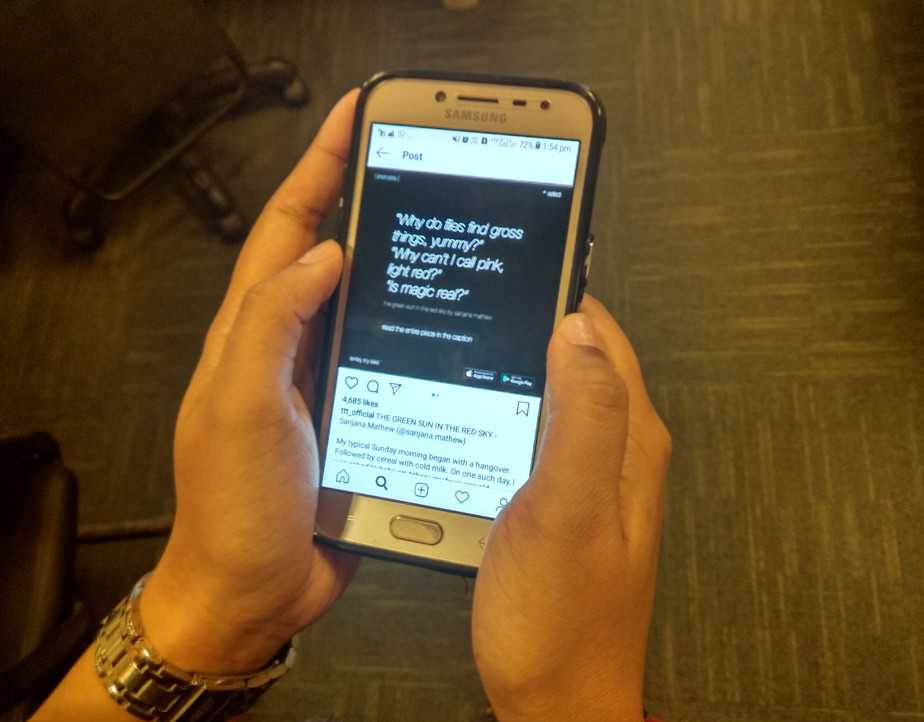The popularity of micro-fiction storytelling platforms is sky-high these days, with millions of people following their pages. Sustained by brand collaborations, these platforms give writers and readers a ground to connect
Ashish Sharma, a 19-year-old hotel management student, started writing when he was in school. Being an introvert, he didn’t have many friends to talk to. One day his English teacher asked him why he doesn’t talk much. When he replied that he didn’t like talking, she asked him to pen down two good and bad things which happen to him every day. Since then he has been following that.
What he followed as a hobby during his childhood, has now turned into a job. Since June 2017, Ashish has been writing for The Scribbled Stories, a micro-fiction storytelling platform, along with pursuing his hotel management degree. He says that writing has played a huge role in developing his personality and has also made him a confident person.

Nowadays, micro-fiction storytelling platforms are booming. They serve as a platform for budding writers to unleash their creativity, without being constrained by deadlines. Brand collaborations are becoming the new key to achieve great market reach, audience, and most importantly — revenue, which is also the case with these micro-fiction storytelling platforms. The way platforms like Terribly Tiny Tales (TTT) and The Scribbled Stories (TSS) have gained traction on social media platforms is a perfect example of cashing in on creativity. But not only is this traction beneficial for the brand and the platform, it is good for the writers too. TTT currently enjoys a following of about 1.2 million people on Facebook and TSS is followed by 2.1 million people.
Since all the micro-fiction platforms are coming up with new ways to connect with the readers, TSS came up with posts on topics which are current and making news. “A piece which I wrote on the Independence Day of Pakistan became quite popular,” says Ashish.
On August 14, Ashish wrote an open letter to Pakistan, which went viral and also got him 500 new followers on his Instagram handle. He received around 250 messages from Pakistan, where people were appreciating his piece, while in India some people branded him ‘anti-national.’ But Ashish chose to ignore such hatred. He says, “If I’m getting 70 per cent love and 30 per cent hate, why would I concentrate on hate?”
Terribly Tiny Tales and The Scribbled Stories have also started writing more on the current issues. To make their platform financially viable, they are relying on branding through merchandise. Stttore.com, the online store of TTT, has a wide range of products, from books of their collector’s edition to black tees representing the colour theme of the brand. “About 80-90 per cent of the business comes from brand collaborations, while merchandise and offline workshops contribute to the rest,” says Chintan Ruparel, co-founder of TTT.
TTT currently has three teams of writers — around 5-6 in-house writers who also curate content, more than a hundred people who look after an app called Tribe, which is a back-end app for the company that has selected writers whose work is published more than other writers. In case of new brand collaborations, the writers for Tribe have an upper hand over other writers of TTT.
Through the official TTT app, their readers can also write and post a micro-fiction piece, and if the TTT curators like it, then it gets published on their Instagram or Facebook page. “In September alone, got 25000 tales from our users,” says Ruparel. He says that in the last three months about 65,000 tales have been written on the app.
Every day, the team at TTT curates almost 500 pieces from the app and selects the most compelling pieces to go on its social media platforms. For its official book, TTT curated the best pieces not just from the writers but from its users too. “We curated them based on the quality and some of them came from our writers too,” adds Ruparel.
In the last five years, TTT has published almost 8,000-9,000 stories on it’s social media platform. Ruparel also believes that the quality of a piece should not be judged by the ‘likes’ it gets. People could’ve also liked those pieces in the moment.”
Recently, TTT also came up TTT Talkies, which consists of short videos for it’s brand collaborations. On coming up with pieces about current topics, which could also be politically charged, Ruparel says, “If it’s highly political then we present both sides of the stories.”
Debroop Roy (22) wrote first for a Facebook page called The Anonymous Writer. After his work started getting published on other platforms too, his interest grew and he started writing more. He has written for The Scribbled Stories and currently writes for Terribly Tiny Tales as part of its select writers programme. It is not only something that he likes, but Roy also earns from writing for TTT. “Mostly it depends on the brand that I’m writing for,” says Roy. The amount usually goes from Rs 1,000 to Rs 5,000. For general pieces on topics like love and relationship, he does not get paid, but he earns Rs 1,000 for the pieces he writes for TTT’s new fictional text-conversation pieces. Roy says that his experience at TTT and TSS has improved his writing a lot. He says, “You read, observe and learn more about it. You improve every day. Even I am still improving,” says Roy, adding,-“Sometimes writing messes up with your head if you can’t push it out. But that’s a risk you need to take.”
Shiza is another writer, who writes micro-fiction pieces for TTT, earlier she used to write for TSS. Her work also got featured in the ninety-seven poems, the second collector’s edition book from TTT. She feels that although a lot of people read micro-fiction these days, yhry are never going to replace books. “I can read 50 micro-fiction tales. But at the end of the day I will always be back to my book,” says Shiza.
Moving on to the next step of storytelling, The Scribbled Stories’ co-founder Mohit Kumar tells us that TSS is coming up with two new platforms. By the end of the year, TSS will launch a new writing and video platform. Currently, TSS gets about 700-800 entries every day.
Speaking on the traction the platform gets, Kumar says, “On Facebook the audience base is much more than Instagram. The demographic is different.” He also says that pieces on current affairs do better on Facebook but that’s his personal observation.
When it comes to covering current affairs in the form of tales, Kumar says that they come up with something which the whole team believes in. “I don’t want to give a half-baked opinion on something in front of 4 million people,” says Kumar.





